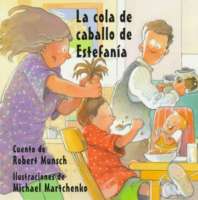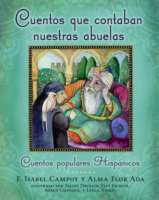 A fun rhythmic text and warm watercolors make this the perfect read-aloud. Full color.
A fun rhythmic text and warm watercolors make this the perfect read-aloud. Full color.
Americas
Materials from the Americas
Fiesta!

Horns, airplanes, and tops. Whistles, gum, and rings. What toys should the children choose? How many candies will they buy? And what will they do with all the things they buy? Open this book to find out and to count with them–in English and in Spanish. It’s easy!
Trompetas, aviones y trompos. Silbatos, chicle y anillos. Cuáles juguetes eligirán los niños? Cuántos dulces comprarán? Y, qué harán con las cosas que comprarán? Abre este libro para contestar esta pregunta y para contar con ellos–en español y en inglés. Verás que es fácil!
Young Zorro (Spanish Edition): El Joven Zorro: La Marca De Hierro

De niño, a Diego le interesaba más montar a caballo y hacer travesuras con su mejor amigo, Bernardo, que luchar contra la injusticia. No obstante, cuando comienzan a desaparecer algunos hombres del pueblo de los Ángeles y ganado del rancho del padre de Diego, él y Bernardo se topan con una injusticia tan grande que tienen que tomar acción.
Inspirada en la novela Zorro de Isabel Allende, que narra cómo Diego de la Vega se convirtió en el legendario héroe enmascarado, El joven Zorro: La marca de hierro introduce a los lectores a una tierra de vaqueros y secuestradores: un mundo lleno de emociones en el que se forma el joven héroe.
Pepita Thinks Pink / Pepita Y El Color Rosado: Pepita Y El Color Rosado (Spanish Edition)

Pepita does not like the color pink and is dismayed to learn that it is the favorite color of the pink little girl who moves in next door.
La Cola De Caballo De Estefania

A little girl who is determined to strike a blow for nonconformity manages to arrive at school every day with a hairdo more outraegous than the day before. And each time, the cast of copycats grows and grows–until the day she threatens to shave her head! The strong female voice will speak to many, asserting the importance of individuality and independent thought. Full color.
Los Pueblos (Pueblos Americanos Nativos) (Spanish Edition)
A history of the Indian groups known collectively as Pueblos because of the sculpture-like villages in which they lived at the time the Spaniards arrived in North America.
The Sensible Book: A Celebration Of Your Five Senses/El Libro Sensible : Una Celebracion De Tus Cinco Sentidos
Questions the child’s perception of each sense. Written in both English and Spanish.
Cuentos Que Contaban Nuestras Abuelas (Tales Our Abuelitas Told): Cuentos Populares Hispánicos (Spanish Edition)

Estos cuentos han viajado por largo tiempo — sobre montañas, a través de mares y desiertos, llevados por el viento, contados por nuestros antepasados. Ahora llegan hasta ti. Una astuta zorra, un pájaro de mil colores, una gaita alegre, y una jovencita audaz…Esta antología de cuentos populares celebra la cultura Hispánica y sus múltiples raíces — indígena, africana, árabe, hebrea, y española. F. Isabel Campoy y Alma Flor Ada han recontado doce cuentos estelares que reflejan la fuerza del espíritu y la extraordinaria herencia de los Latinos. Cuatro ilustres artistas latinos enriquecen esta colección inolvidable.
Abc X 3 English, Espanol, Francais

From airplane/avión/avion to zigzag/zigzag/zigzag, Marthe Jocelyn and Tom Slaughter have created a unique ABC for the very young. The book works perfectly in three languages, English, Spanish, and French (English, Español, and Français). In each case, deceptively simple paper cuts will delight the eye while young readers explore words in three languages.
The book has been carefully constructed to accommodate each language, including the letters which occur in Spanish, but not in English or French. Earlier collaborations by Tom Slaughter and Marthe Jocelyn have received raves from critics. This new addition to their library is yet another excellent introduction to modern art, to words, and this time to the fun of languages
Estrellas Peregrinas / Walking Stars: Cuentos De Magia Y Poder / Magic And Power Stories

First ever Spanish-language edition of the critically acclaimed collection of short stories for young adults by a master of Latino literature “We’re all walking stars,” the eighty-four year old guide tells Victor Villaseñor as he travels to his mother’s birthplace, La Lluvia de Oro. “Don’t you know what we all are? We are all stars that come from the heavens.” In Estrellas peregrinas, the Spanish-language edition of his critically acclaimed collection of short stories for young adults, Villaseñor shares that enchanted world with the reader. Magic rains down from the heavens like stars, coating each of the family stories in a sheen of la vida as it should be: filled with power and surprises that give each character the strength to endure. The stories brim with a cast of extraordinary characters in challenging situations: the young girl on her first day of school who shows bravery even in the face of school-yard taunts . . . a young man about to be hanged that can only be saved by the miracle of song . . . and the young boy who faces El Diablo in a dark peach orchard. Through it all, the characters truly show themselves to be walking stars, tiny luminous sparks of light, and they are able to affect change in their lives and the world around them by relying on their bravery, their strength, and their faith in themselves. These are the stories of ancestors long-past, stories that will scrape off the dust of modernity on the reader’s skin to show the glowing beings that Villaseñor and his family believe we once were and can still be.
